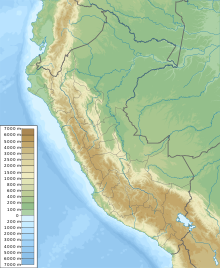| Second siege of Callao | |||||||||
|---|---|---|---|---|---|---|---|---|---|
| Part of the Peruvian War of Independence | |||||||||
 The port of Callao in 1838 | |||||||||
| |||||||||
| Belligerents | |||||||||
|
|
| ||||||||
| Commanders and leaders | |||||||||
|
Land army: Blockade army: |
| ||||||||
| Strength | |||||||||
|
Bolivarian forces: 4,700 soldiers[1] (half of them Colombians)[2][3] Naval force: 1 schooner brig 2 frigates 2 corvettes 3 brigs 3 gunboats 171 guns 914 crew |
Royalist army in Callao: 4,000 refugees | ||||||||
| Casualties and losses | |||||||||
|
177 casualties during combat 2,500 casualties outside of the fortress Several dead due to disease |
767–785 killed in action 1,312 dead due to disease Total: 6,000 dead (including civilians) 14 deserters 80 surrendered | ||||||||
Location within Lima | |||||||||
The second siege of Callao was the longest lasting siege that occurred on the Pacific coast during the Spanish American wars of independence. The siege was carried out by the combined Gran Colombian and Peruvian independence forces against the royalist soldiers defending the Real Felipe Fortress in the port of Callao, who refused to surrender, and refused to accept the capitulation of the Battle of Ayacucho.
The siege took place from December 5, 1824 to January 23, 1826, when the royalist stronghold was defeated, ending the Spanish Empire's presence in South America.[4]
- ^ De La Barra, Felipe. La Campaña de Junín y Ayacucho. p. 219.
- ^ Miller, 1829. p. 246
- ^ Encina, 1954. p. 644.
- ^ "José Ramón Rodil y Galloso". Real Academia de la Historia.


